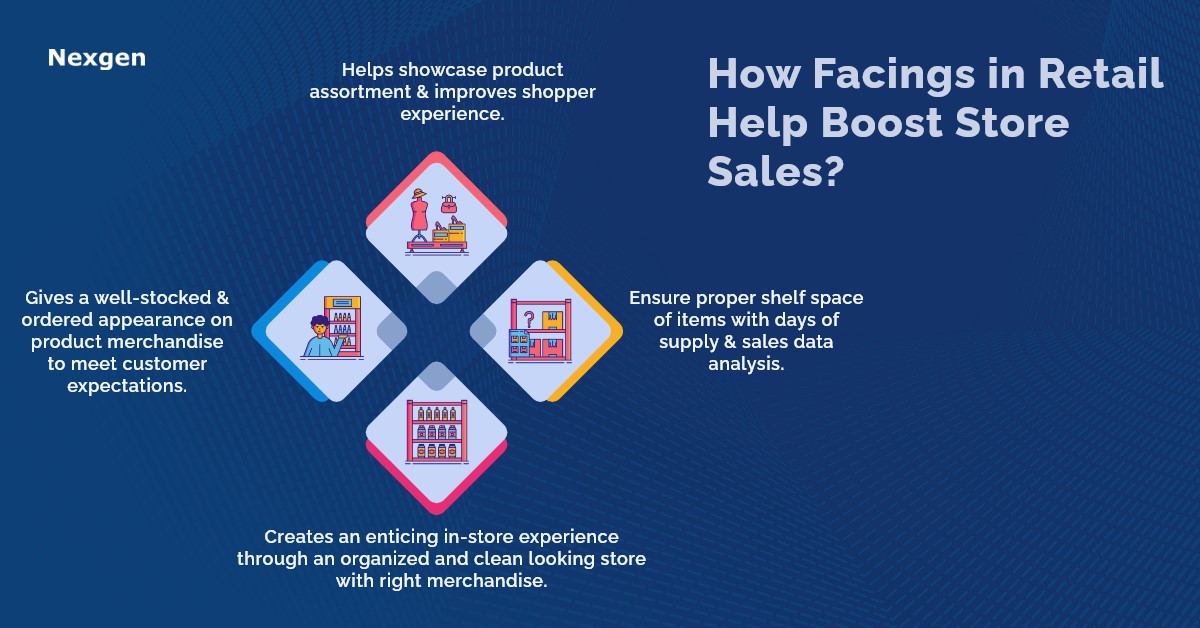A successful retail store depends on more than just a marketing plan or a product range to draw customers. As a retailer, you need to understand what shoppers need and expect from your store when they first walk in, and whether your store provides it.
During a six-month period, it has been reported that 60% of shoppers had a negative shopping experience, because of disorganized and empty shelves, which caused most shoppers to leave the store without buying anything. The reason behind this is that they do not have a proper shelf planning solution. That is where planogram in retail come in. Planograms are visual merchandising tools, that help retailers plan and execute store facings efficiently to entice shoppers. Planograms will help you present products accurately by giving them the right facings and space they need to perform well on shelves. This helps retailers boost their sales and improves store performance.
What is Facing in Retail?
The retail success of your store depends on many factors, like product merchandising, store layout, and pricing. Facing serves as the final touch that gives your store a well-stocked and ordered appearance when all these variables combine to meet customer expectations. This helps bring products to the front of the shelf and make sure that labels are facing forward. This contributes to the store's appearance of being clean, stocked, and organized. Customers who like a positive shopping experience may locate things intuitively, which makes it simpler for them to view your product ranges and purchase just what they need. So, the following are some advantages of using facing in retail stores:

- Improves shopper experience: Facing helps shoppers quickly find the items they are looking for. This makes their shopping effortless, increasing ease and speed. When a new shopper visits your store, the facing is how you can help them showcase your entire product assortment. If only a few of your products are visible, they may walk out with a product that is not the right one – or without buying anything at all.
- Memorable branding: Retail branding gives your store an enticing look, that shoppers can easily remember. Signage, color, scents, and lighting are key building blocks of your branding. Facing helps bring those elements together and makes your shelves drive customer attention.
- Easier inventory control: When you make facing as your retail strategy, it helps showcase certain items that are more popular than usual, or when shelves are staying fully stocked for longer. This ensures inventory control in the short run. For example, you might increase your next order of certain items because you feel there is an immediate peak in customer demand for them. In such cases, it is best to provide more shelf space for that product category.
Planogram Reasons to Improve Facing of Your Store
- Helps keep the store organized and clean: If you want to please your shoppers, your store cannot be disorganized or messy. This is precisely the scenario you can face if you ignore your retail facings. For example, let’s say that you have recently experienced the evening rush hour. Shoppers have visited, purchased what they needed, and left your store in a mess. They may have placed unwanted items in random places in your store or turned fully organized shelves into partially empty ones. If you do not try to fix such issues, it may give a negative impression among shoppers. Shoppers would not prefer to shop from your store, or they would even think about shopping before the evening rush happens. That is why you need to fix the shelves as often as necessary to drive sales.
- It helps to create a store shoppers want to re-visit: Retailers need to create and maintain an organized, clean-looking store that not only invites shoppers in, but also encourages them to stay and purchase. You can improve in-store experiences by developing assortments that are targeted at shoppers. For example, retailer A and retailer B are selling FMCG goods. Retailer A does not have a merchandising structure. Meanwhile, retailer B has paid attention to its retail facings to fill the gaps between the shelves and maintain an organized shelf full of merchandise. People would like to visit retailer B’s store since it has created an enticing retail environment where a shopper would want to shop.
- Create a direct impact on sales and profit: As a retailer, it is important to consider how much facings should be given for each product. Giving the wrong item too many facings could result in losing out on sales as your best-selling item may not have enough shelf space. This could even lead to negative growth in your product category, which has a direct impact on the rest of your store. When a product with more facing is not performing well on shelves, you are left with stock that you cannot sell. So, how do you ensure that your products have the right number of facings? By analyzing your sales data or days of supply to ensure proper shelf space among products.
Overview of Nexgen POG
Nexgen POG is a robust and user-friendly cloud-based visual merchandising tool. It is designed for quick and efficient planogramming with minimal effort. Planogram in retail can be designed by easily dragging and dropping the products. The multi-device compatibility feature of POG allows you to obtain, share and edit planogram on any device, including your phone. It helps in designing store-specific planograms for increased product visibility and sales.
Get Your Free Trial Now!